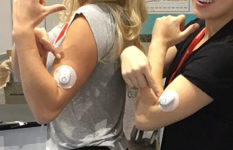Overview
Diabetes is a common disease, yet every individual needs unique care. Diabetes is signaled by an elevated blood sugar level of more than 126 milligrams per deciliter (mg/dL) for a fasting blood test, or more than 200 mg/dL at any time during the day. It can also be indicated by a hemoglobin A1c level of 6.5 percent or higher, a measure of the percentage of blood sugar attached to hemoglobin in the blood during the past two to three months. (Hemoglobin is a protein in red blood cells that transports oxygen throughout the body. So an A1c of 6.5 means that 6.5 percent of your red blood cells have sugar attached to them. Unchecked high blood sugar gradually damages the blood vessels in your body. Over the long term, this slow, progressive harm can lead to a dangerous loss of sensation in your legs and feet, a loss of eyesight and kidney function, and an increased risk for heart disease and stroke.
 There are 29 million children and adults in the United States, or 9% of the population, who have diabetes. While an estimated 80 millions are in condition of so called pre-diabetic, which will likely to progress to diabetes if no actions are taken to control their glucose level.
There are 29 million children and adults in the United States, or 9% of the population, who have diabetes. While an estimated 80 millions are in condition of so called pre-diabetic, which will likely to progress to diabetes if no actions are taken to control their glucose level.
Type 1 Diabetes
Results from the body’s failure to produce insulin, the hormone that “unlocks” the cells of the body, allowing glucose to enter and fuel them. It is estimated that 5-10% of Americans who are diagnosed with diabetes have type 1 diabetes.
Type 2 Diabetes
Results from insulin resistance (a condition in which the body fails to properly use insulin), combined with relative insulin deficiency. Most Americans who are diagnosed with diabetes have type 2 diabetes.
Gestational Diabetes
Immediately after pregnancy, 5% to 10% of women with gestational diabetes are found to have diabetes, usually, type 2.
Pre-diabetes
Pre-diabetes is a condition that occurs when a person’s blood glucose levels are higher than normal but not high enough for a diagnosis of type 2 diabetes. Type 2 diabetes is the most common form of diabetes. In type 2 diabetes, either the body does not produce enough insulin or the cells ignore the insulin. Insulin is necessary for the body to be able to use glucose for energy. When you eat food, the body breaks down all of the sugars and starches into glucose, which is the basic fuel for the cells in the body. Insulin takes the sugar from the blood into the cells. When glucose builds up in the blood instead of going into cells, it can cause two problems: Right away, your cells may be starved for energy, and Over time, high blood glucose levels may hurt your eyes, kidneys.
Symptoms
Although diabetes are common among people with over weight, diabetes often goes un-diagnosed because many of its symptoms seem so harmless. Recent studies indicate that the early detection of diabetes symptoms and treatment can decrease the chance of developing the complications of diabetes. Some diabetes symptoms include:

– Frequent urination
– Excessive thirst
– Extreme hunger
– Unusual weight loss
– Increased fatigue
– Irritability
– Blurry vision
If you have one or more of these diabetes symptoms, see your doctor right away.
Diagnosis and Treatment
We encourage people with diabetes and their families to learn as much as possible about the latest medical therapies and approaches, as well as healthy lifestyle choices. Good communication with a team of experts can help you feel in control and respond to changing needs. One of the main aspects of creating a treatment plan for diabetes is recognizing whether the patient has type 1 or type 2 diabetes. Fr om there a treatment plan can be formulated for that specific type. Treatment for diabetes requires keeping close watch over your blood sugar levels (and keeping them at a goal set by your doctor) with a combination of medications, exercise, and diet.
om there a treatment plan can be formulated for that specific type. Treatment for diabetes requires keeping close watch over your blood sugar levels (and keeping them at a goal set by your doctor) with a combination of medications, exercise, and diet.
If the patient has type 2 diabetes, sometimes eating healthy and engaging in physical activity is not enough. The patients doctor may give he or she oral medication to help control their blood glucose levels. For people with type 1 diabetes (and some people with type 2 diabetes) this means taking insulin. Patients with type 1 diabetes must take insulin to control diabetes and this can only be done through multiple injections or by an insulin pump, a small device that delivers insulin continuously throughout the day.
Glucose Control and Use of CGM
Control your blood sugar as close to normal as possible helps you feel better and reduces the risk of long-term complications of diabetes. People with diabetes work to keep their blood sugar as near to normal as possible. Keeping your blood sugar in your target
range can help prevent or delay the start of diabetes complications such as nerve, eye, kidney, and blood vessel damage. Tight control means getting as close to a normal (nondiabetic) blood glucose level as you safely can.
Studies have shown use of continuous glucose monitoring system have significant clinical benefits. It allows patients understand changes in their glucose level and identify hidden risks, it allows doctors for early diagnosis, disease prevention and complication control. Its unique features including real-time alert for administration of insulin medication helps doctors achieve improved control of glucose level and lower rate of hypoglycermia. For more information on how to use CGM for better glucose control, click here
Live Healthy with Diabetes
By paying close attention to what and when you eat, you can minimize or avoid the “seesaw effect” of rapidly changing blood sugar levels, which can require quick changes in medication dosages, especially insulin. By combining medications, exercise, and diet, the patient can achieve optimum health on their road to recovery. When the patient has type 1 or type 2 diabetes, that patient needs to be very aware of not only what he or she eats, but also when and how much he or she eats. Hiring a Certified Diabetes Educator can work with the patient to develop a healthy meal plan that fits the patient’s lifestyle. Following a meal plan can also help you lose weight and lower your risk of developing complications. Adherence to a diabetic diet is a critical aspect of controlling blood sugar in people with diabetes.
 When considering an ideal diabetic diet, several factors must be taken into consideration, including the amount and type of carbohydrates consumed as well as the amount of fiber , fat, and protein contained in foods. Glycemic index and glycemic load are further considerations. Foods with low glycemic index and load raise blood sugar more slowly than high glycemic index/load foods. Glycemic index refers to a standardized measurement, while glycemic load takes a typical portion size into account.
When considering an ideal diabetic diet, several factors must be taken into consideration, including the amount and type of carbohydrates consumed as well as the amount of fiber , fat, and protein contained in foods. Glycemic index and glycemic load are further considerations. Foods with low glycemic index and load raise blood sugar more slowly than high glycemic index/load foods. Glycemic index refers to a standardized measurement, while glycemic load takes a typical portion size into account.
When thinking about exercise, it is important that the patient’s physical activity is monitored when trying to control diabetes and prevent complications such as heart disease and high blood pressure. By walking for 30 minutes or getting a light jog in every morning can help prevent complications and control the patient’s diabetes in the long run.

